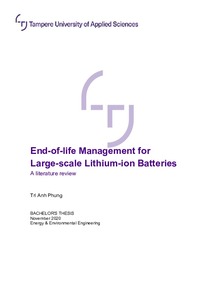End-of-life management for large-scale lithium-ion batteries : a literature review
Phung, Tri Anh (2020)
Phung, Tri Anh
2020
All rights reserved. This publication is copyrighted. You may download, display and print it for Your own personal use. Commercial use is prohibited.
Julkaisun pysyvä osoite on
https://urn.fi/URN:NBN:fi:amk-2020111522881
https://urn.fi/URN:NBN:fi:amk-2020111522881
Tiivistelmä
Lithium-ion batteries are on the rise because of the trend for renewable energy and electric vehicles. Amassing in large quantities, posing possible and major consequence risk, lithium-ion battery waste critically needs a responsible handling plan. This thesis was to communicate a comprehensive battery waste management strategy to holders and future disposers of large-scale lithium-ion batteries. To meet this objective, a literature review was conducted on three types of documents, which are (i) international legislation and treaties, (ii) industrial reports conducted by consultant agencies, and (iii) publications in academic and scientific journals.
The journey of battery waste was identified. Planning for the end-of-life required a formal Decommission Plan, which oversaw risks factors, safety measures, and socio-environmental impacts. Waste transportation adhered to international treaties specifically applicable to end-of-life lithium-ion batteries. The containment of battery waste must be made of protective materials and properly labelled. Eligibility for second-life application was determined by batteries’ remaining electric capacity storage and safety performance. Despite environmental benefits, second-life batteries were challenged by falling costs of new batteries. In term of recycling, hydrometallurgy was highly efficient and most popular recycling method for end-of-life lithium-ion batteries. After acid leaching, solvent extraction, and precipitation, cobalt, nickel, manganese, and lithium were extracted from battery scraps. Ultra-high heat pyrometallurgy was reportedly only operational at two recycling plants in Japan and Belgium; however, low-to-medium heat treatment were commonly implemented for removal and deactivation. Currently under development direct cathode recycling may have large potential in battery recycling. The refurbished cathode could be used in new battery manufacturing. For demonstration, this thesis included relevant examples of commercial recycling operators and a case study of a preliminary battery waste management plan for an R&D energy storage project.
This thesis conclusively recommends disposers of large-scale lithium-ion batteries to plan diligently for the decommission phase, follow laws in package and transportation, conduct battery diagnostic tests then consider for second-life, opt for hydrometallurgy recycling operators, meanwhile donate one battery module to research centers for developing direct cathode recycling technique.
The journey of battery waste was identified. Planning for the end-of-life required a formal Decommission Plan, which oversaw risks factors, safety measures, and socio-environmental impacts. Waste transportation adhered to international treaties specifically applicable to end-of-life lithium-ion batteries. The containment of battery waste must be made of protective materials and properly labelled. Eligibility for second-life application was determined by batteries’ remaining electric capacity storage and safety performance. Despite environmental benefits, second-life batteries were challenged by falling costs of new batteries. In term of recycling, hydrometallurgy was highly efficient and most popular recycling method for end-of-life lithium-ion batteries. After acid leaching, solvent extraction, and precipitation, cobalt, nickel, manganese, and lithium were extracted from battery scraps. Ultra-high heat pyrometallurgy was reportedly only operational at two recycling plants in Japan and Belgium; however, low-to-medium heat treatment were commonly implemented for removal and deactivation. Currently under development direct cathode recycling may have large potential in battery recycling. The refurbished cathode could be used in new battery manufacturing. For demonstration, this thesis included relevant examples of commercial recycling operators and a case study of a preliminary battery waste management plan for an R&D energy storage project.
This thesis conclusively recommends disposers of large-scale lithium-ion batteries to plan diligently for the decommission phase, follow laws in package and transportation, conduct battery diagnostic tests then consider for second-life, opt for hydrometallurgy recycling operators, meanwhile donate one battery module to research centers for developing direct cathode recycling technique.
